In and around Kelling
Highlights:
Hobby x3
drake Garganey x2
Little Tern x3
Gannet x12
Lesser Whitethroat x3 +
Grey Partridge x2
Little Ringed Plover x2
Common Sandpiper
Woodlark x 2
Marcus' report is shown below:
11th May 2018 – Norfolk in May, Day 1
Day 1 of a three day long weekend of tours today, back in Norfolk. We would be spending the days looking for spring migrants and summer visitors along the coast. It was a dry and bright day today, sunny at times, but with a strong and blustery wind.
We started the day with a drive round via a couple of sites for Nightingales first thing, as we made our way east. Numbers seem to be down again this year, but they are still just about clinging on in North Norfolk. They have been rather quiet this year too, not singing as much as in previous years, and it was perhaps not a surprise that we didn’t hear one today. They are always best at dawn or dusk and the cold wind didn’t help today either.
Still, we had a nice walk at the second location and there were plenty of other birds singing. We heard several Blackcaps and a nice male perched up in the brambles in front of us. There were a couple of Chiffchaffs duetting too, and a Song Thrush deep in the bushes. A Green Woodpecker laughed at us from the trees.
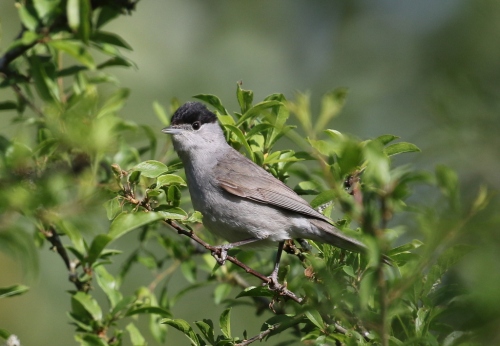
Blackcap – there were several singing this morning
We didn’t linger here long today. There was a report of a couple of Garganey down at Kelling, so we headed straight down there, figuring we could explore in the shelter of the lane on our walk out. When we arrived in the village, there were several Swallows and a couple of House Martins over the village, the latter prospecting the eaves of the tea rooms again.
A Hobby appeared over the fields just beyond the tea rooms and we watched as it hung in the air and gradually drifted towards us. We could see its orange ‘trousers’ as it turned in the sun. It was joined by a second Hobby, we could see they were a pair, and they dropped down behind the houses out of view. Smart birds and a good start!
The lane was quiet at first as we walked down, apart from all the Rooks in the wood behind the school, which were decidedly noisy! A Kestrel was hovering at the base of Muckleburgh Hill. As we got down to the copse, there was a bit more activity. A Chiffchaff was singing from a dead branch at the top of a tree beside the lane. Two Blackcaps were singing off against each other in the copse itself.
As we approached the Water Meadow, we could just see two Grey Partridge which had been spooked and flew across the water towards us. They landed out on the grass briefly before scurrying off into the rushes. In the cultivated field the other side, a single Stock Dove was feeding with the Woodpigeons and a Brown Hare was just behind. There were several Sand Martins hawking for insects over the water and we had nice views of one of the Common Whitethroats singing in the top of the hedge.
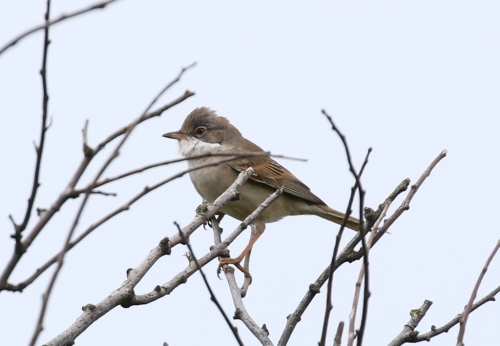
Whitethroat – singing in the hedge along the lane
From this side of the pool, we could see a few ducks out on the water – three Shoveler and a pair of Gadwall – but there was no sign of any Garganey at first. Thankfully they were just asleep in the grass on the bank at the top end, and we couldn’t see them until got down to the crosstrack.
There were two smart drake Garganey here. We got them in the scope and could see the bold white supercilium on the one which was out in the open. We walked down to the far corner for a better view, and when we got there they were both awake and feeding, swimming in and out of the flooded grass around the edge of the pool, snapping at insects. Great to watch!
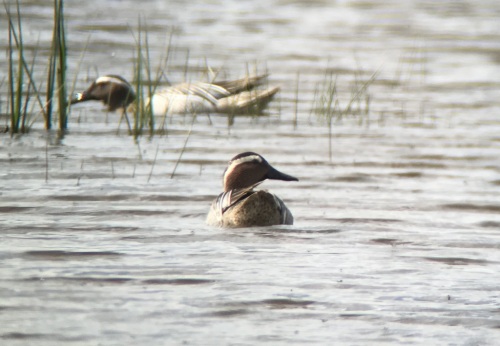
Garganey – two drakes were on the Water Meadow this morning
There were a few other birds around the Water Meadow today. An Avocet flew in calling. A Reed Warbler was singing away from the reeds by the path, though it kept down out of view, and a Sedge Warbler was singing too, a little further along.
We had nice views of Reed Buntings – a male singing, and a female in the top of the blackthorn. While we were watching the female, a Lesser Whitethroat appeared in the branches just behind. Typically more skulking than the Common Whitethroats, we got a couple of good looks at it. As usual, there were lots of Linnets here, always good to see.
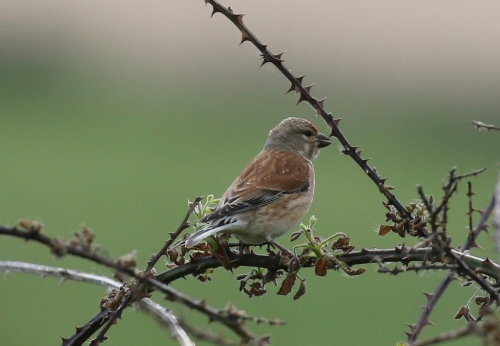
Linnet – there were lots in the brambles around the Water Meadow
As we walked up the path over the hillside beyond, we could hear a Stonechat. We looked over to see the male on a bramble stem. He flew across and we noticed the female dart into a bush, presumably going in to the nest. A few moments later, she reappeared nearby. There were plenty of Meadow Pipits here too, flying up from the grass as we passed.
From the top of the hill, we had a quick look out to sea. Several terns were flying back and forth just offshore – at least six Little Terns, and a couple of Sandwich Terns too. Further out, we spotted a line of twelve adult Gannets flying east – it would be interesting to know where they were off to at this time of year. A lone Kittiwake flew past too.
On our way back down towards the Quags, a Kestrel hovered above us. It then turned to chase off a passing Marsh Harrier, a young male. As we walked back past the Water Meadow, another Marsh Harrier appeared, a different bird, a female, hunting the fields to the west. It was promptly chased by a couple of Carrion Crows, and circled up right over our heads.
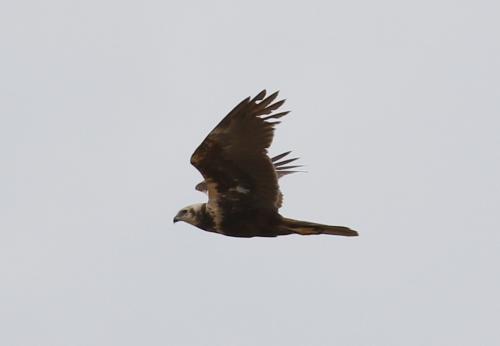
Marsh Harrier – two were hunting the fields by the Water Meadow today
It was nice and sheltered in the lane and had warmed up now in the sunshine. On the walk back, we saw a nice selection of butterflies – Orange Tip, Green-veined and Small White, and Speckled Wood.
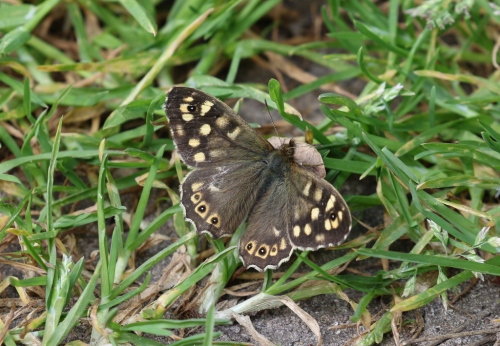
Speckled Wood – we saw a couple on our walk back up the lane
We headed round towards Cley next. We wanted to stop at Iron Road, but there were too many cars there already, so we drove back and parked at Salthouse green. It was not too far to walk back to Iron Road, and there were lots of geese out on the grazing marshes – Greylags, Canadas and a pair of Egyptian Geese.
There was not much of note on the Iron Road pool, despite it looking great for waders at the moment. We could just see a Redshank, a Lapwing, and a few Gadwall hiding in the grass at the back. So we walked round to Babcock Hide to try our luck there. Two small young Lapwings were down in the grass around the pools by Attenborough Walk.
From the hide, we could see two Little Ringed Plovers on the mud towards the back. A Common Sandpiper was over to one side. When the Common Sandpiper walked over towards the plovers, they chased it off. Thankfully, it landed down on the mud in front of the hide, where we had much better views of it.
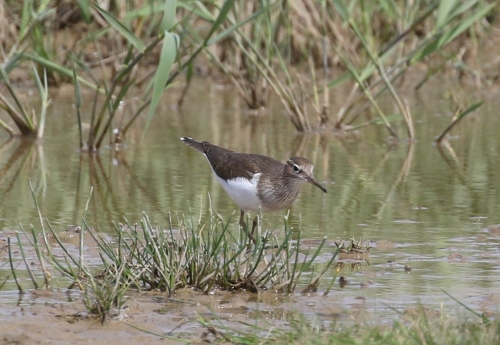
Common Sandpiper – showed well in front of Babcock Hide
It is that time of year, when birds are getting down to breeding. It was all happening in front of Babcock Hide today! We were watching a pair of Avocets out in the water, standing around preening. The female then bent forward and held her head with the bill straight, just above the water. The male walked round for a few seconds before eventually flying up and landing on her back.

Avocets – this pair were mating out on Watling Water
A pair of Pied Wagtails were feeding on the mud right in front of the hide. When the female stopped and stood still, the male started an elaborate display, shuffling round her with wings and tail spread, turned towards her with one wing in the air. Eventually the female bowed and lifted her tail and we watched them mating.
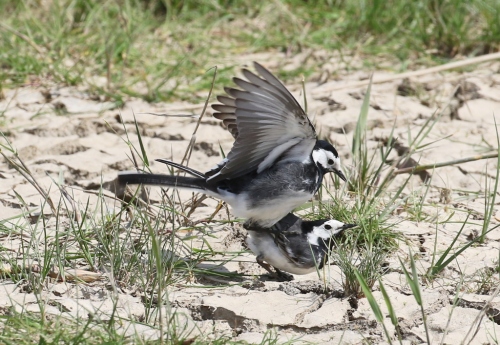
Pied Wagtails – mating in front of Babcock Hide
Time was getting on now, so we headed round to the Visitor Centre at Cley for a late lunch, and made good use of the picnic tables outside. We got the scope out and scanned Pat’s Pool, where we could see lots of godwits out in the water. There were both Black-tailed and Bar-tailed Godwits here, although they seemed to have segregated themselves into two separate groups.
Several of the godwits were coming into breeding plumage, and we had a closer look at one very smart Bar-tailed Godwit, which was already deep rusty below, continuing all the way down under the tail. We could also see two Knot and two Dunlin with the Bar-tailed Godwits. Several Marsh Harriers were coming and going too, and we picked up three Common Swifts feeding out over North Scrape, our first of the day.
After lunch, we headed up to the Heath. It was exposed and a bit windy up here this afternoon, not ideal conditions. We checked out a couple of spots for Dartford Warblers, but they were keeping well tucked down today. We did see a nice Hobby which flew in along the ridge, right past us and out across the Heath.
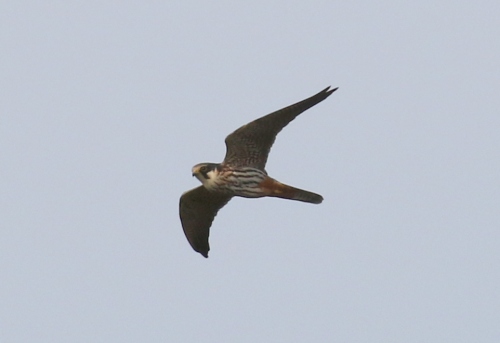
Hobby – our third of the day, over the Heath
There were lots of Linnets around the gorse and we eventually found a smart male Stonechat perched in the top of one clump. We tried a couple of places for Woodlark but couldn’t find any where we thought they might be. However, we were just walking away from the second spot when we heard singing in the distance and watched as a Woodlark flew in and circled over right where we had been standing just a couple of minutes earlier!
There were a few warblers up on the Heath this afternoon. On our walk back, we heard a Garden Warbler singing deep in the trees. A Willow Warbler was singing too and we watched it in a small oak tree by the path, flitting around the among emerging leaves.
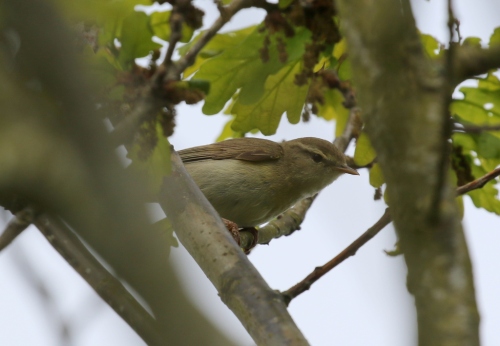
Willow Warbler – singing in a small oak tree on our walk back
Unfortunately, it was time to call a close to day one and head back. More tomorrow!
No comments:
Post a Comment
Note: only a member of this blog may post a comment.